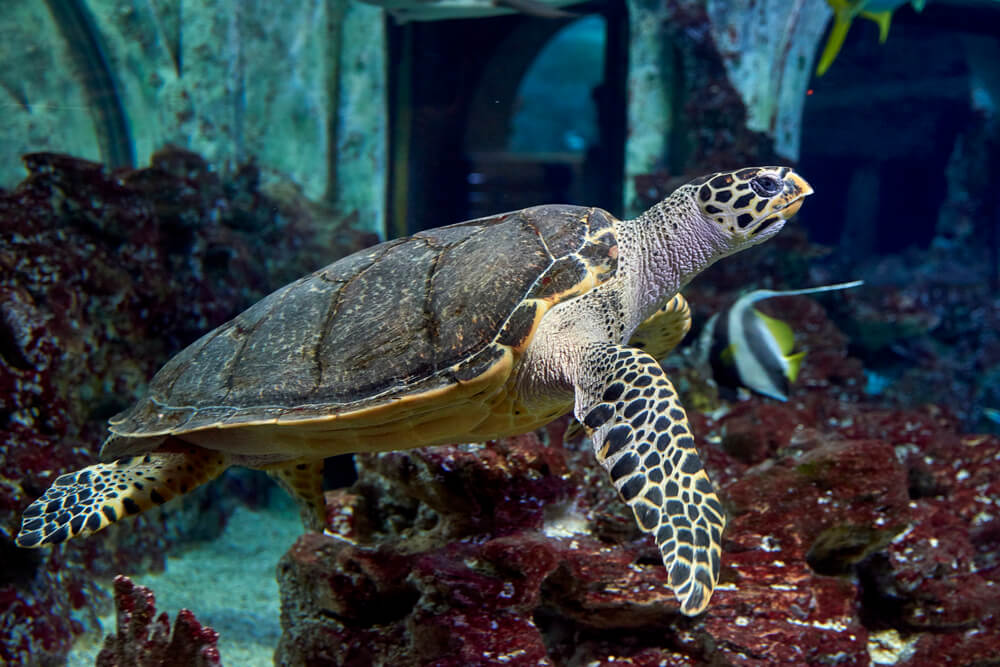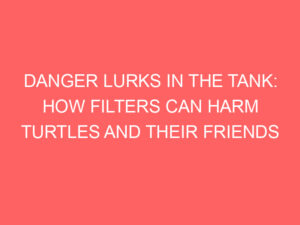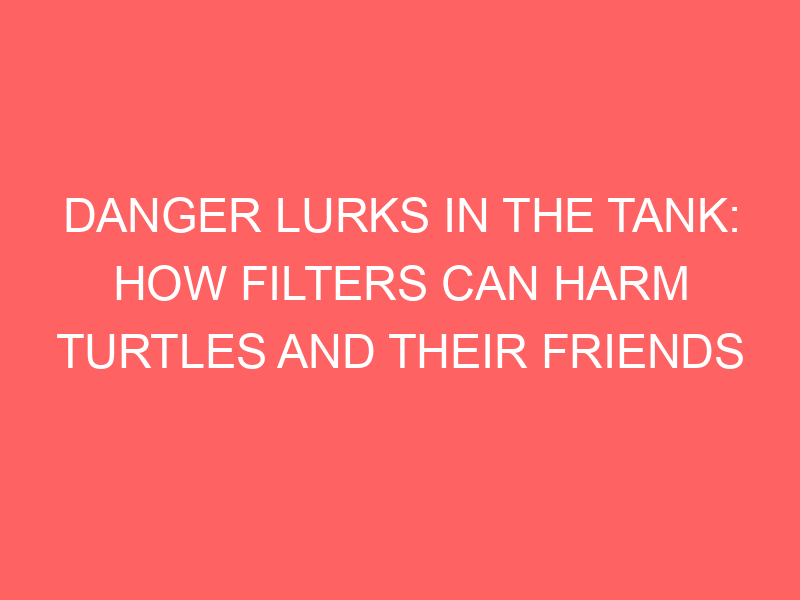Measuring the water quality of your turtle tank is essential for ensuring your pet’s health and well-being. To measure water quality, you need to test the pH balance, ammonia, nitrite, and nitrate levels of the tank’s water.
The most important test when measuring water quality is testing for pH balance. For example, a healthy turtle tank should have a pH level between 6.5 and 8.0; higher or lower than this range can lead to health issues in turtles, such as shell rot or respiratory problems.
Test kits that measure the pH balance of a tank are readily available at pet stores or online retailers.
In addition to checking the pH balance, it’s essential to also check for ammonia, nitrite, and nitrate levels.
Ammonia promotes the growth of bacteria that can be harmful to turtles, so it should be kept at 0 parts per million (ppm). Nitrite should also be at 0 ppm, as it is another form of bacteria; however, nitrate levels should remain between 20 and 40 ppm.
Test kits that measure these levels are available in pet stores or online retailers too.
What Are the Signs of Poor Water Quality in a Turtle Tank?
Besides monitoring the parameters discussed above, there are other signs of poor water quality in a turtle tank. These include:
- Cloudy or discolored water – If the water in your turtle tank is dirty or has a yellow tint, this could be an indication that something is wrong with its quality.
- Algae blooms – Too much light and nutrients can cause algae to grow on surfaces like stones, rocks, and glass. If you notice an excessive amount of algae growth, it could be an indicator of poor water quality.
- Unpleasant smell – As mentioned before, ammonia build-up can lead to foul odors coming from the tank. This could indicate that your turtles’ habitat is not being properly filtered or maintained.
- Drooping plants – Over time, poor water quality can lead to plants in your turtle tank becoming wilted and drooping. If this is the case, it could signify something is wrong with the habitat’s environment.
By monitoring your turtle tank’s parameters regularly and keeping an eye out for these signs of poor water quality, you can ensure that your turtles live in a healthy and safe environment.
In addition, if you ever notice any indication that the water may be contaminated or unhealthy, don’t hesitate to take action immediately!
Properly maintaining the water quality of your turtle tank will help keep them happy and healthy for many years to come.
How Often Should I Test My Turtle’s Water Quality With an Aquarium Kit?
Water quality tests should be done regularly to ensure that your turtle’s environment is safe and healthy. The testing frequency depends on several factors, such as the size of the tank, how many turtles are in it, what type of food you feed them, and how often you change the water.
For most turtle tanks with one or two turtles, water quality tests should be done about once every two weeks.
When testing for water quality, there are some key components to look for: pH (acidity/alkalinity), ammonia, nitrite, and nitrate levels.
Each element has a different ideal range for a turtle tank; for example, an optimal pH range for turtle tanks is between 6.5-8.0. To get the most accurate reading, use an aquarium test kit that tests all four components simultaneously.
Make sure to perform a 25% water change and clean out any debris from the tank before testing.
If your water quality test results are outside their ideal range, immediately adjust the tank parameters as needed or perform a larger water change.
Remember to add back essential minerals and electrolytes with a dechlorinator after every water change, as this will help keep your turtle healthy and happy!
With regular monitoring and maintenance, you can ensure that your turtle’s environment is safe and enjoyable for years to come.
How Can I Reduce Nitrite Levels in My Turtle Tank?
The best way to reduce nitrite levels in a turtle tank is by doing regular water changes. Nitrites are created when beneficial bacteria break down the ammonia released from turtles’ waste and leftover food.
Regular water changes can help dilute these nitrites and thus reduce their level of them in your tank. Staying on top of the weekly water change schedule will keep the waters clean, healthy, and safe for your turtles.
Additionally, it is crucial to test your water regularly for nitrates, as high nitrate levels can be toxic for turtles. If you find that your levels are too high, you may need to perform additional or more frequent water changes.
To help further reduce nitrite levels, consider adding an aquarium filter system to your turtle tank, which will help to filter out excess nitrites and other contaminants.
Finally, feeding your turtles the proper amount and type of food is important. Overfeeding or providing too much of one type of food can lead to increased nitrite levels in the water since turtles’ waste contains ammonia.
Feeding them a balanced diet and properly managing their leftovers can help reduce the chances that these nitrites will reach toxic levels.
What Are the Chemicals Needed To Maintain Good Water Quality in a Turtle Tank?
A key part of maintaining good water quality in a turtle tank is regularly testing the levels of various chemicals. The main chemicals to keep an eye on in our pH, are ammonia, nitrite, and nitrate.
PH: This measures how acidic or basic the water is. The ideal range for a turtle tank is 7.0-8.4.
Ammonia: This can be toxic to turtles and other aquatic life if present at high levels for prolonged periods. Ammonia levels should always remain at zero or close to it.
Nitrite: Similar to ammonia, this chemical is also toxic if present in high concentrations over long periods. Therefore, nitrite should also remain at zero or close to zero. Nitrate is less harmful than ammonia and nitrite but should remain below 20 mg/L to maintain good water quality.
You can use test strips or liquid tests to measure these levels in your tank. Test strips are more convenient but may not be as accurate as liquid tests. It’s also important to regularly clean and change the tank filter media to ensure the chemicals don’t build up to dangerous levels.
Finally, remember that a healthy turtle needs plenty of clean and filtered water to stay healthy! Regular testing will help ensure your pet stays happy and healthy for years to come.
Correctly maintaining the chemical balance of your turtle tank is essential for creating a safe habitat for your pet.
Can Aquarium Salt Be Used in a Freshwater Turtle Aquarium Setup?
Aquarium salt can be used in a freshwater turtle aquarium setup. However, it should not replace the regular cycling of water in the tank.
Aquarium salt is usually intended to supplement or slightly raise the salinity of already established freshwater tanks and should never be added directly to a tank containing turtles.
To measure the water quality in a turtle tank, you must first calculate the total dissolved solids (TDS) of your tank’s water using a TDS meter. This will tell you how hard or soft your water is based on how many minerals are dissolved in it.
You’ll also need to test the pH, ammonia, nitrate, and nitrite levels. Depending on your turtle’s species, you may also need to check for other elements, such as calcium or magnesium.
It’s important to regularly clean out the tank removing uneaten food, feces, and any algae build-up that might occur over time. This will help maintain a healthy environment for your turtles and prevent their health from being compromised due to substandard conditions.
Keeping the water clean will help ensure the TDS meter stays accurate over time so that you can monitor any changes in the water quality.
To summarize,
Aquarium salt can be used in a freshwater turtle tank setup carefully and with proper monitoring. Still, it should always be the same as regular water changes to maintain the optimal quality of your tank’s environment.
Testing the TDS level and other elements such as pH, ammonia levels, nitrate levels, and nitrite levels are necessary for keeping your turtles healthy and safe. Regularly cleaning out the tank will also help maintain a healthy environment for your turtles.
With these measures in place, you can ensure that your turtle aquarium is at its best!














